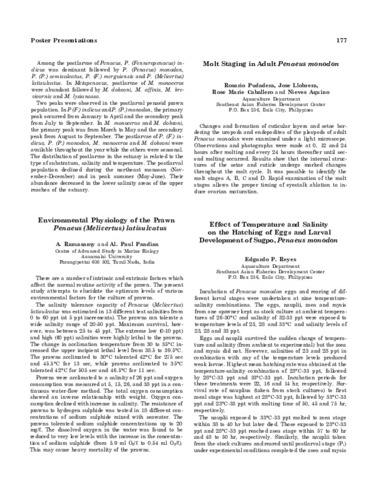Environmental physiology of the prawn Penaeus (melicertus) latisulcatus
- Global styles
- MLA
- Vancouver
- Elsevier - Harvard
- APA
- Help
Share
抄録
There are a number of intrinsic and extrinsic factors which affect the normal routine activity of the prawn. The present study attempts to elucidate the optimum levels of various environmental factors for the culture of prawns.
The salinity tolerance capacity of Penaeus (Melicertus) latisulcatus was estimated in 13 different test salinities from 0 to 60 ppt (at 5 ppt increments). The prawns can tolerate a wide salinity range of 20-50 ppt. Maximum survival, however, was between 25 to 45 ppt. The extreme low (0-10 ppt) and high (60 ppt) salinities were highly lethal to the prawns. The change in acclimation temperature from 30 to 35°C increased the upper incipient lethal level from 38.5 to 39.5°C. The prawns acclimated to 30°C tolerated 42°C for 275 sec and 45.5°C for 13 sec, while prawns acclimated to 35°C tolerated 42°C for 505 sec and 46.5°C for 11 sec.
Prawns were acclimated to a salinity of 26 ppt and oxygen consumption was measured at 5, 15, 26, and 38 ppt in a continuous water-flow method. The total oxygen consumption showed an inverse relationship with weight. Oxygen consumption declined with increase in salinity. The resistance of prawns to hydrogen sulphide was tested in 18 different concentrations of sodium sulphide mixed with seawater. The prawns tolerated sodium sulphide concentrations up to 20 mg/ℓ. The dissolved oxygen in the water was found to be reduced to very low levels with the increase in the concentration of sodium sulphide (from 5.9 ml O2/ℓ to 0.54 ml O2/ℓ). This may cause heavy mortality of the prawns.
記述
Abstract only.
Suggested Citation
Ramasamy, A., Pandian, Al.P. (1985). Environmental physiology of the prawn Penaeus (melicertus) latisulcatus. (Abstract only). In Taki Y., Primavera J.H. and Llobrera J.A. (Eds.). Proceedings of the First International Conference on the Culture of Penaeid Prawns/Shrimps, 4-7 December 1984, Iloilo City, Philippines (p. 177). Iloilo City, Philippines: Aquaculture Department, Southeast Asian Fisheries Development Center.
Type
Conference posterISBN
9718511008



